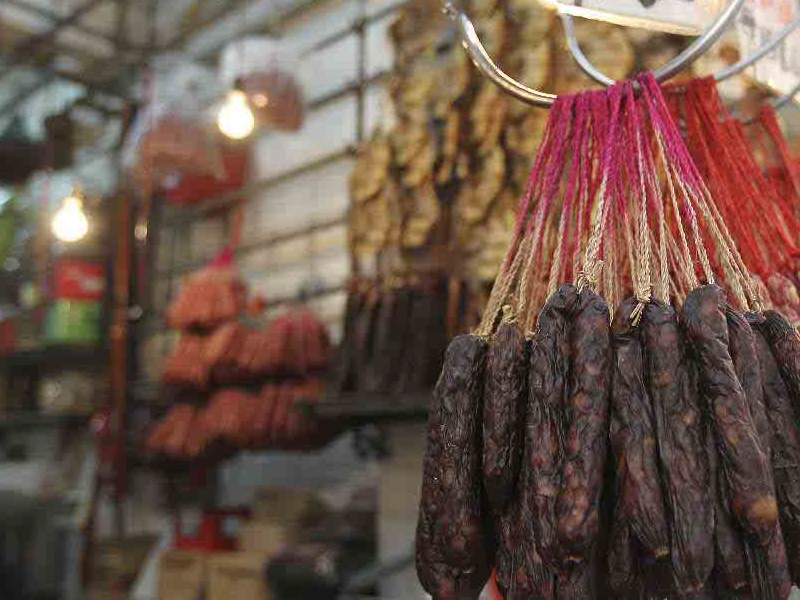EVERY YEAR, Saveur, an American high-end food magazine, runs a list of hot food trends. This year it dedicated a full page to “Chinese charcuterie”. To those of us living in Hong Kong, the pictures were familiar: pink pork sausages speckled with fat and made with fragrant rose wine (laap cheung), dark pudgy goose, pork or duck liver sausages (yuen cheung), thick strips of preserved pork belly (laap yuk), and flattened salted ducks (laap ngaap).
Laap mei, also called wax meats or air-dried meats, are a southern Chinese speciality. They are a winter treat and many companies stop making them after Lunar New Year and only start up again in August. Aside from their being delicious, one of the most rewarding things about investigating laap mei is discovering how resolutely old-fashioned Hong Kong’s cured meat industry remains.
While many Hong Kong foods are mass produced, overprocessed, or shipped frozen from the mainland, its sausages, for the most part, are still handmade the traditional way by families with generations of experience, and hung to dry in dim, cramped working spaces in Western district. Despite all the talk about how old Hong Kong is disappearing, in the world of laap mei, the old ways live on.
Old school heroes
Sam Hing Lung in Western district is the poster child for old-school artisanal sausage making. A proud family company, Sam Hing Lung was started by Lee Ji Xing, who is now 82.
When we arrived, Xing was napping on a cot beneath the low beams that crisscross the small factory space (during high season, the beams are heavy with drying sausages).
He woke up and talked about his company with obvious pride.
Xing says he learned from famous laap mei masters before setting up his own company between 40 and 50 years ago. He can’t remember exactly when, although he says it was “before electricity” when the “sausages were still dried over charcoal”.
Today, Sam Hing Lung still uses mei kuei lu chiew rose wine to season the meat, Xing has upgraded the quality of other ingredients, using pork sourced from the Netherlands. The company offers laap cheung in varying degrees of fattiness, and yuen cheung made from duck and goose liver. The company is known for its yuen cheung made with no fat, and densely packed with pure goose liver.
Although Sam Hing Lung stops producing after the Lunar New Year, it still shifts more than 30,000 catties (18,140kg) during each five-month season.
Off-season, you need to order in bulk (15 catties, or about 9kg, if you’re on Hong Kong Island, and 20 catties if you live in Kowloon).
Quantity and quality
Yue Wo Hop Kee in Sai Ying Pun was started by owner Fu Chau-wing’s father-in-law in the 1970s. The sausages are made in a small factory downstairs from Sam Hing Lung but, unlike that company, it operates a storefront on Connaught Road West.
Yue Wo Hop Kee also has restaurants and supermarkets as clients, which ensures it is busy all year round. Even though it can sell a whopping 1,000 catties (604kg) a day during the high season, the sausages are still made by hand in the traditional manner.
Yue Wo Hop Kee uses meat from the hind leg of the pig for extra flavour in its laap cheung. It sells a thinner sausage with no additional fat, and a special one using pork shoulder-butt, which produces a tender sausage. For the yuen cheung, it sources goose livers from France and the US.
A tradition of luxury
No discussion of laap mei would be complete without mentioning Yung Kee, one of Hong Kong’s most famous restaurants. Yung Kee is renowned for its roast goose, but many people say that its laap mei is equally praiseworthy.
Foodies love Yung Kee’s ngo yuen cheung, or goose liver sausage. Yvonne Kam, the granddaughter of Yung Kee’s founder, claims they were the first to sell goose liver sausages in Hong Kong.
“In the past people would do it with duck liver, but because we sell a lot of roast goose and we have our own contract farm in China, we have very good ingredients,” she says.
All of the liver comes from the same geese Yung Kee raises for roasting. The laap cheung is 70 per cent collar butt meat from the neck, to which a bit of leg meat and fat have been added.
“Laap cheung has to be fatty or it won’t be good,” says Kam. Then they are stuffed in casings that are one year old. Any younger and they are too chewy, any older they are too brittle.
All this attention to detail costs money, but even though it’s some of the most expensive laap mei on the market, it flies off the shelves. Yung Kee only stocks the meat from the Mid- Autumn Festival until the end of spring.



